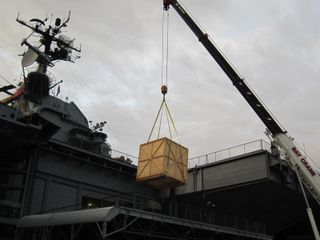Russian Space Capsule Touches Down at NYC Museum

NEW YORK — It's no small feat to move a flown space capsule into a museum, especially if that museum is built within a converted World War II-era aircraft carrier docked on the west side of Manhattan.
Officials here at the Intrepid Sea, Air and Space Museum used a crane to lift a giant wooden box from Manhattan's Pier 86 into one of the aircraft carrier's hangars today (Oct. 18). Inside the box was a Russian-built Soyuz spacecraft that returned one NASA astronaut, one cosmonaut and one space tourist to Earth at the end of their missions at the International Space Station.
The Soyuz TMA-6 capsule is on loan to the Intrepid and will be the latest addition to the museum's outer space exhibit. [See photos of Soyuz capsule at the Intrepid]
Once in place, the capsule was unpacked and wheeled to its new temporary home. The Soyuz spacecraft is roughly 7 feet (2 meters) tall and 7 feet (2 m) wide, and its charred exterior is evidence of the capsule's fiery re-entry through Earth's atmosphere.

A space-flown capsule
The Russian spacecraft has its place in history because it was the vehicle that carried Greg Olsen, the third private citizen to fly in space, back to Earth at the end of his tourist trek to the International Space Station in 2005.
Olsen returned home alongside Russian cosmonaut Sergei Krikalev and NASA astronaut John Phillips, who both completed long-duration stays aboard the orbiting lab as part of the outpost's Expedition 11 mission.
Get the Space.com Newsletter
Breaking space news, the latest updates on rocket launches, skywatching events and more!
Olsen was on hand at the Intrepid today and reminisced about his trip into space six years ago. [Photos: The First Space Tourists]
"The most memorable thing for me was blasting off," Olsen told SPACE.com. "I remember thinking about how much I'm going to enjoy the next 10 days."
Olsen launched to the station as a paying passenger on a different Russian Soyuz spacecraft on Oct. 1, 2005. His trip, which reportedly cost $20 million at the time, was brokered in a deal with the Russian Federal Space Agency through Space Adventures, an American space tourism firm based in Virginia.
The space tourism industry essentially began in 2001, when American entrepreneur Dennis Tito paid a reported $20 million to fly to the International Space Station. Since then, six other multimillionaires, including Olsen, have paid for similar orbital jaunts, and they have come to be known as pioneers of private spaceflight.
"It's a nice group," Olsen said. "We try to get together as often as possible."

Reminiscing about a space-tourism trip
Olsen, a scientist and entrepreneur, founded the optics firm Sensors Unlimited, based in Princeton, N.J. His ticket to the space station was largely paid for by the sale of his company in 2000. And while he is eager to travel in space again, Olsen notes that ticket prices have gone up in the six years since his visit. Space Adventures' most recent arranged trip to the space station in 2009 reportedly cost $35 million.
"I'd love to go again, but I'd have to sell another company first," Olsen said. "These things are getting more and more expensive."
Still, as he watched the Soyuz spacecraft get lifted into the Intrepid, Olsen reminisced about his spaceflight experience, including the Soyuz capsule's notoriously close quarters.
"It's definitely small," he said. "We have a habitation module to float around in after, but probably for the first three hours after liftoff it's the most cramped, and also during landing."
The Intrepid will also be the future retirement home of NASA's space shuttle prototype, Enterprise. The floating museum was awarded the shuttle earlier this year following the retirement of NASA's 30-year space shuttle program. [NASA's Shuttle Program in Pictures: A Tribute]
The Intrepid won Enterprise from a pool of 21 museums hoping to house it or one of the agency's three space-flown shuttles. Enterprise is currently housed at the Smithsonian's National Air and Space Museum's Steven F. Udvar-Hazy Center outside of Washington, D.C.
The Smithsonian is slated to receive the shuttle Discovery, while Endeavour will go to the California Science Center in Los Angeles. Atlantis, which flew NASA's final shuttle mission, will go on display at the Visitors Complex of the Kennedy Space Center in Cape Canaveral, Fla.
You can follow SPACE.com staff writer Denise Chow on Twitter @denisechow. Follow SPACE.com for the latest in space science and exploration news on Twitter @Spacedotcom and on Facebook.
Join our Space Forums to keep talking space on the latest missions, night sky and more! And if you have a news tip, correction or comment, let us know at: community@space.com.

Denise Chow is a former Space.com staff writer who then worked as assistant managing editor at Live Science before moving to NBC News as a science reporter, where she focuses on general science and climate change. She spent two years with Space.com, writing about rocket launches and covering NASA's final three space shuttle missions, before joining the Live Science team in 2013. A Canadian transplant, Denise has a bachelor's degree from the University of Toronto, and a master's degree in journalism from New York University. At NBC News, Denise covers general science and climate change.